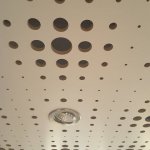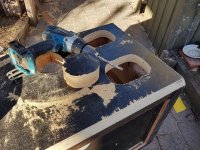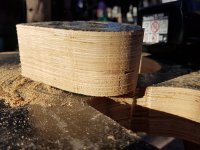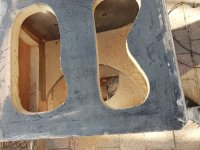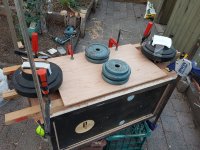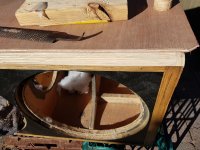Hollowboy-- have you had a chance to mock up a panel and see if you're actually getting good enough bonding ood the honeycomb for it to affect the structure of the panel? I'm worried that, without the second skin, that it may not be really helping. Affixed with a decent epoxy?
I often thought about a honeycomb cabinet. I work at a place that builds interiors for the aerospace industry.
I bought some 1/4" carbon fiber honeycomb when playing around with exciters (DML) 😀
I bought some 1/4" carbon fiber honeycomb when playing around with exciters (DML) 😀
Hollowboy-- have you had a chance to mock up a panel
Nope, my workshop time has been spent on other projects (including non-speaker furniture) - but I should make up a test box soon.
I did tests + a rough build with sandwich panels a while ago (MDF - polystyrene sheet - MDF), which gave me a practical appreciation of the theory, mainly that panel thickness = strength, and (within reason) the core can be a relatively fragile material.
I'm worried that, without the second skin, that it may not be really helping.
I'm not sure what you mean. My idea is to have a full outer skin, and a full (perforated) inner skin - like the pictured acoustic panel.
Affixed with a decent epoxy?
I'll try my usual goop:
For normal wood and ply, I just use PVA.
For non-porous stuff I use 'TechGrip' pllyurethane glue.
On everything else, like gap filling / stuff with uneven edges, I use cheap 'liquid nails' - lots of it.
Any of them make a fine bond. I've broken up a few test boxes, and the wood often tears apart before the joins do.
---
PS - I thought this thread was appropriate for 'construction tips' & I'm not sure why it got moved to multi-way. It's a discussion of materials and construction ideas that is just as applicable to other types of box (i.e. a fullrange or subwoofer box).
Attachments
Last edited:
Loosely related: doing a tweak of an old box.
I'm putting a new skin on (4mm braceply, 5mm bamboo). The original box is already double walled, so I'm honeycombing it to keep the weight reasonable. A minor bonus is that the box will have slightly more internal volume.
Using a drill + jigsaw, I was surprised at how quickly I was able to make the cutouts. Laminating the skin layers on is the slow part.
I'm putting a new skin on (4mm braceply, 5mm bamboo). The original box is already double walled, so I'm honeycombing it to keep the weight reasonable. A minor bonus is that the box will have slightly more internal volume.
Using a drill + jigsaw, I was surprised at how quickly I was able to make the cutouts. Laminating the skin layers on is the slow part.
Attachments
Is there anything that'd involve less work, e.g. is there an off-the-shelf source of honeycomb material that isn't prefinished (both sides sealed)?
I'm late to the party, as usual. You may have solved this problem or moved on, but, FWIW:
Many years ago I played around with some honeycomb from a company called Nida-Core. At that time, you could get the bare unlaminated polyproylene core with open cells, or you could get the core with a lightweight fabric scrim attached that would saturate well for bonding your own outer laminates. A wide range of thicknesses were available, and it seems like they offered unlaminated AL and cardboard cores as well. Lots of options.
That was mid-90's, but I would expect these product options to be available somewhere. IIRC, Aircraft, boating and shipping were target industries for the products.
I'm late to the party, as usual. You may have solved this problem or moved on
Still interested. Also, old threads are potentially useful for more people than just the OP.
honeycomb from a company called Nida-Core. [...] I would expect these product options to be available somewhere. IIRC, Aircraft, boating and shipping were target industries for the products.
Looks like it is still available in Australia, thanks - and is not crazy expensive. There's someone (not near me, sadly) selling several panels (about 6m^2) for $135. They are also selling a catamaran, so I guess the panels are leftovers.
Some pertinent explanation here: Composite core construction video by Tech Ingredients
That was a great video. Thank you for posting.
From the DML topic, vertical grain Balsa is also used as a filler/spacer in boat construction.
That may be easier to source and attach.
That may be easier to source and attach.
Some pertinent explanation here: Composite core construction video by Tech Ingredients
Thanks for that! Quick search turned up a number of suppliers of the balsa and it isn't expensive. What skins would be appropriate/available/reasonably priced?
Thanks for that! Quick search turned up a number of suppliers of the balsa and it isn't expensive. What skins would be appropriate/available/reasonably priced?
No one has any thoughts here? Looking for something widely available, reasonably priced, easy to fabricate.
I'd use several layers of glass cloth inside and out, first lams of glass done between mylar sheets on a nice flat surface (sheet of glass) then make balsa end-grain.
Bond end-grain sheet to glass laminate, sand balsa then bond glass over that.
The only hard part is making the end-grain panel.
I've been tinkering with the idea of making a composite cabinet, the killer for me is the cost of the uhd foam...... the boggle is making the core as almost a 'whole' so the fabric can be templated with overlaps inside and out, less chance of it springing if dropped.
I have vac bagging kit so would infuse the whole mess.
Bond end-grain sheet to glass laminate, sand balsa then bond glass over that.
The only hard part is making the end-grain panel.
I've been tinkering with the idea of making a composite cabinet, the killer for me is the cost of the uhd foam...... the boggle is making the core as almost a 'whole' so the fabric can be templated with overlaps inside and out, less chance of it springing if dropped.
I have vac bagging kit so would infuse the whole mess.
...widely available, reasonably priced, easy to fabricate.
Balsa panels are available pre-skinned, either timber veneer or composite.
I had samples from an Australian manufacturer who could fabricate to order at not unreasonable cost (by boat builder standards).
I haven't used balsa core for speakers because I wasn't much concerned about transportability.
I have started to skin my ply enclosures with aluminium, which meets your 3 criteria.
Acts as a constrained layer too and can also act as a heatsink for the drivers, if you built the front panel so the driver frames are thermally connected.
Best wishes
David
You could use the alu panels as the base to bond balsa directly and avoid one fabrication step from the previous post.
Last edited:
I have started to skin my ply enclosures with aluminium, which meets your 3 criteria.
Skin layers of almost any kind seem to work well - panels with complex composition usually have better damping than simpler ones.
Where are you getting 'reasonably priced' alu?
Skin layers of almost any kind seem to work well
Al over ply makes sense as a composite structure - stiffer material as skin, lower density core, can be well damped with the correct bond layer.
I made an effort to heatsink the speaker driver frames with the front face, the thermal properties are a bonus of al compared to epoxy/cloth laminate.
I took a whole sheet, 3 m x 1.2 m x 3 mm thick so I had trade price from a commercial supplier - about $250 from Alucon IIRC, it's been a while, I could check.'reasonably priced' alu?
'Reasonable' is subjective but the sheet was sufficient for a whole system with all JBL 18" subs, 15" woofers, 4" compression drivers and slot tweeters.
So a fraction of the total driver cost.
Best wishes
David
I do like your idea for a honeycomb core with perforated al internal face.
You say it would take thousands of holes to do yourself.
With a depth stop on the drill you could hammer them out in a second or two, done in an hour or so.
Admittedly a tedious hour but doable.
Last edited:
'Reasonable' is subjective but the sheet was sufficient for a whole system with all JBL 18" subs, 15" woofers, 4" compression drivers and slot tweeters.
So a fraction of the total driver cost.
That pricing logic works for me. Even with more humble drivers, the amount of work+time that goes into a big build makes that expense seem fairly minor. Spending $250 on a skin isn't crazy; the bamboo I'm skinning with was $140 for a similar amount of material.
Is your system pictured somewhere? The description makes it seem like something I'd fancy. Which CD are you running from 700Hz?
I do like your idea for a honeycomb core with perforated al internal face.
You say it would take thousands of holes to do yourself.
The number required would depend on the core material. A simple honeycomb (like in Patrick Bateman's post that I was replying to) has no openings between the cells, so you would need thousands of tiny perforations to make them communicate with the enclosure's internal volume. The plastic grid I bought (as pictured in post 4) does have openings between the cells, so only a few big perforations would be required.
I started a build using the plastic grid - then I had to move my workshop, then I got sidetracked with life & another project - so I haven't finished it 🙁
With a depth stop on the drill you could hammer them out in a second or two, done in an hour or so.
Admittedly a tedious hour but doable.
Does this assume a drill press?
From the DML topic, vertical grain Balsa is also used as a filler/spacer in boat construction.
That may be easier to source and attach.
NO longer It proved a Hollow promise. It soon enough turned to rotted Mush under the inevitable water seepage thru the not actually watertight f'glass skins.
Balsa Cored construction, currently Means = run away.. as fast as you can.
Do a search on kraft paper honeycomb core. You will get a wealth of products, suppliers, and tech reports on different types. There’s lots of factors all explained in some of the studies.
Is your system pictured somewhere? The description... Which CD?
No pictures yet, still need to skin the cabinets and finalize the CD horns.
I picked up 2447 and horns from JBL while I was in the USA but never really used them, decided to build custom horns and went for the 2453 because its smaller size allowed more freedom on the horn depth.
..sidetracked with life & another project - so I haven't finished it
I just need to finish my bandsaw renovation... to cut the steel to widen my hydraulic press... to bend the aluminium to skin the cabinets.
And then I'm ready to start the new mid horns...
So I know about this...
Does this assume a drill press?
Not really, I expect the internal skin would be fairly thin, 0.9 mm was mentioned IIRC.
With the panel on the floor it would be easy to lean on a hand drill pretty hard, almost punch thru it - just need a depth stop so as not to hit the other skin.
Best wishes
David
With the panel on the floor it would be easy to lean on a hand drill pretty hard, almost punch thru it - just need a depth stop so as not to hit the other skin.
Knowing where to place the drill bit for each hole would be my concern. I wouldn't expect the core pattern to be visible through 0.9mm AL. I guess you could lay the core over the skin, secure it in place temporarily and give it a shot of spray paint to show the pattern. That would require some alignment provisions to be sure it was reattached in the same orientation, unless you drilled it prior to lamination.
Perforated AL would be great if it could be matched to a honeycomb geometry.
- Status
- Not open for further replies.
- Home
- Loudspeakers
- Multi-Way
- Alu honeycomb panel
